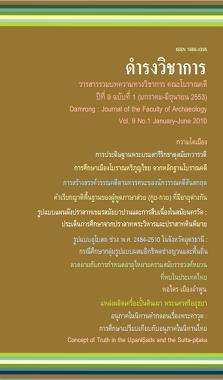AYUTTHAYA CERAMIC PRODUCTION DURING THE 15TH TO 18TH CENTURIES
Keywords:
อยุธยา, เครื่องปั้นดินเผา, แหล่งผลิตAbstract
The objective of this research is to study ceramics and describe the process of Ayutthaya ceramic production from the Klong Sra Bua and Klong Bang Koad kiln sites, Phra Nakhon Si Ayutthaya. Research has mapped, though archaeological and ethnographic data, the development and changes of Ayutthaya ceramic manufacture, and identified cross-cutural regularities and variavilities in producted by the Department of Fine Arts’ excavation team, between 1999-2002, at the Klong Sra Bua and Klong Bang Kuad kiln sites, Phra Nakhon Si Ayutthaya. Other studies in clude: comtemporary ceramic ethnographical observations and surveys in related regions ( especially Pattani province, southern Thailand), the Far-east, Middle-east, and the Indian subcontinent.
The hypothesis to be tested is whether some ceramic manufacture of Ayutthaya period learnt from experienced potters, who taught the next generation through traditional methods, and where the sudden change in process of ceramic manufacture in Ayutthaya Klong Sra Boa and Klong Bang Kuad Kiln sites derived. For example, the primarily kiln firing cross- cultural potters, and later app;ied to generate products which matched their own styles, behavior and environment.
A comparative study was conducted with typological classifications of the archaeological excavation records. Ethnological data was then applied to interpret archaeological data for ceramic production, with the core results listed below: Ayutthaya ceramic production was located on both banks of the Klong Sra Bua, located north of the island city, around the second half of the 15th century A.D. Initially, they produced mainly architectural meterials, especially tiles; probably on royal demand.
The ceramic makers were experts in oblong updraft kiln firing techniques and settled on the western bank of the canal, conducting their trade for more than a hundred years. Later, a need for architectural materials forced them to embrace a new kiln technology; a semi dome draft kiln, introduced by the main Chinese ethnic groups who settled in Ayutthaya and also featured prominently in court and commerce. This technique was applied throughout the later period of Ayutthaya, dating from the first half of 17th century until the 18th century; the decline of the Ayutthaya Kingdom.
Apart from architectural materials, various earthen potteries were also produced. Another ethnic group settled on the eastern bank of Klong Sra Bua whose open bonfire techniques were typically practiced to make storage vessels and pots that served as kitchenware.
References
คุรุสภา, องค์การค้า. พระราชพงศาวดารกรุงศรีอยุธยา เล่ม ๑ ฉบับพระจักร-พรรดิพงศ์ (จาด). กรุงเทพฯ: โรง พิมพ์คุรุสภา, ๒๕๐๔
โบราณคดีและพิพิธภัณฑสถานแห่งชาติ ที่ ๓ พระนครศรีอยุธยา, สํานักงาน. รายงานการขุดค้นทางโบราณคดีแหล่งผลิตเครื่องปั้นดินเผาคลองสระบัวคลองบางขวดและคลองเมืองจังหวัดพระนครศรีอยุธยา. ๒๕๔๔
พระยาโบราณราชธานินทร์. รวมเรื่องกรุงเก่า พิมพ์เนื่องในงานพระราชทานเพลิงศพ นางสาวเพ็ญ เดชะคุปต์ เป็นกรณีพิเศษ ณ ฌาปนสถานกองทัพบก วัดโสมนัสวิหาร วันที่ ๑๒ ธันวาคม พ.ศ. ๒๕๔๑
ศิลปากร, กรม. คําให้การชาวกรุงเก่าคําให้การขุนหลวงหาวัดและพระราชพงศาวดารกรุงเก่าฉบับหลวงประเสริฐอักษรนิติ์. กรุงเทพฯ: โรงพิมพ์เจริญ ธรรม, ๒๕๑๕
Gingzheng, Wang. ADictionaryofChineseceramics, Singapore: Sun Tree Publishing Limited, 2002
Needham, Joseph. Science&CivilisationinChina: Volume 12. Cambridge: Cambridge University Press, 2004.
Downloads
Issue
Section
License
บทความนี้เป็นผลงานของข้าพเจ้าแต่เพียงผู้เดียว และ/หรือเป็นผลงานของข้าพเจ้าและผู้ร่วมงาน ตามชื่อที่ระบุในบทความจริง และเป็นผลงานที่มิได้ถูกนำเสนอหรือตีพิมพ์ที่ใดมาก่อน





